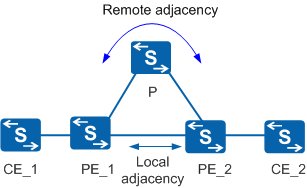Coexistent Local and Remote LDP Session
When a local node establishes both local and remote LDP adjacencies with the same LDP peer, local and remote LDP sessions coexist.
Figure 1 shows a coexistent local and remote LDP session between two nodes.
In Figure 1, when the local LDP adjacency is deleted due to a failure in the link to which the adjacency is connected, the peer type may change without affecting its presence or status. (The peer type is determined by the adjacency type, which can be local, remote, and coexistent local and remote.) If the link becomes faulty or is recovering from a fault, the peer type and corresponding session type may change. The session however stays Up and is not deleted or set to Down.
A typical application of coexistent local and remote LDP session is Layer 2 virtual private network (L2VPN). In Figure 1, L2VPN services are transmitted between PE_1 and PE_2. When the direct link between PE_1 and PE_2 is disconnected and then recovers, changes in the peer and session types are as follows:
- MPLS LDP is enabled on the directly connected PE_1 and PE_2, and a local LDP session is set up between them. PE_1 and PE_2 are then configured as the remote peer of each other, and a remote LDP session is set up between them. PE_1 and PE_2 maintain both local and remote adjacencies. In this case, a coexistent local and remote LDP session is set up between PE_1 and PE_2 to transmit L2VPN messages.
- When the physical link between PE_1 and PE_2 goes Down, local LDP adjacency goes Down. The route between PE_1 and PE_2 is reachable through the P, which indicates that the remote LDP adjacency is still Up. The session type changes to remote so that it can remain Up. The L2VPN is uninformed of the session type change and does not delete the session. This avoids the neighbor disconnection and recovery process and therefore reduces service interruption time.
- When the physical link between PE_1 and PE_2 recovers, local LDP adjacency goes Up. The session type is restored to coexistent local and remote and remains Up. Again, L2VPN is uninformed of the session type change and does not delete the session. This reduces service interruption time.
